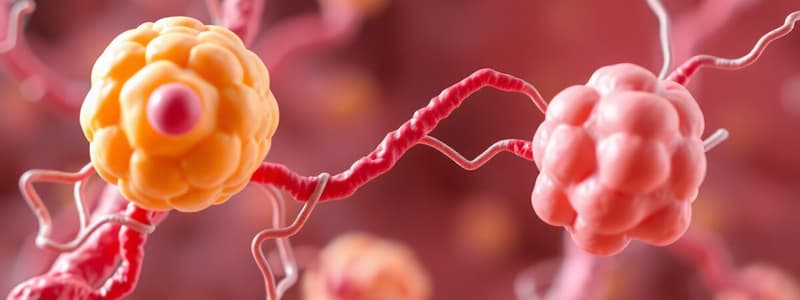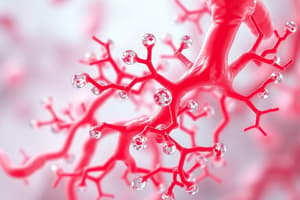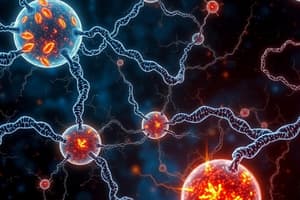Podcast
Questions and Answers
During intense exercise, gluconeogenesis becomes essential to maintain blood ______ levels, ensuring tissues like the brain have a continuous energy supply.
During intense exercise, gluconeogenesis becomes essential to maintain blood ______ levels, ensuring tissues like the brain have a continuous energy supply.
glucose
In gluconeogenesis, the enzyme ______ bypasses the hexokinase reaction in glycolysis by hydrolyzing glucose-6-phosphate to glucose in the endoplasmic reticulum of liver and kidney cells.
In gluconeogenesis, the enzyme ______ bypasses the hexokinase reaction in glycolysis by hydrolyzing glucose-6-phosphate to glucose in the endoplasmic reticulum of liver and kidney cells.
glucose-6-phosphatase
The conversion of pyruvate to phosphoenolpyruvate (PEP) in gluconeogenesis involves two enzymes: pyruvate carboxylase, which converts pyruvate to ______ in the mitochondria, and PEPCK, which converts oxaloacetate to PEP.
The conversion of pyruvate to phosphoenolpyruvate (PEP) in gluconeogenesis involves two enzymes: pyruvate carboxylase, which converts pyruvate to ______ in the mitochondria, and PEPCK, which converts oxaloacetate to PEP.
oxaloacetate
[Blank] inhibits gluconeogenesis by reducing the expression of PEPCK and glucose-6-phosphatase genes, while glucagon stimulates gluconeogenesis by increasing their expression.
[Blank] inhibits gluconeogenesis by reducing the expression of PEPCK and glucose-6-phosphatase genes, while glucagon stimulates gluconeogenesis by increasing their expression.
In gluconeogenesis, ______ is activated by acetyl-CoA, signaling the increased need to process pyruvate, while fructose-1,6-bisphosphatase is inhibited by AMP, indicating a high energy charge.
In gluconeogenesis, ______ is activated by acetyl-CoA, signaling the increased need to process pyruvate, while fructose-1,6-bisphosphatase is inhibited by AMP, indicating a high energy charge.
Gluconeogenesis helps regulate acid-base balance by consuming ______, which aids in maintaining blood pH during metabolic processes.
Gluconeogenesis helps regulate acid-base balance by consuming ______, which aids in maintaining blood pH during metabolic processes.
The Cori cycle involves gluconeogenesis in the liver, which converts ______ produced by muscles during anaerobic glycolysis back into glucose.
The Cori cycle involves gluconeogenesis in the liver, which converts ______ produced by muscles during anaerobic glycolysis back into glucose.
A key regulatory point in gluconeogenesis is the dephosphorylation of fructose-1,6-bisphosphate to fructose-6-phosphate, catalyzed by the enzyme fructose-1,6-______.
A key regulatory point in gluconeogenesis is the dephosphorylation of fructose-1,6-bisphosphate to fructose-6-phosphate, catalyzed by the enzyme fructose-1,6-______.
Glycerol, released from the breakdown of ______ in adipose tissue, serves as one of the primary precursors for gluconeogenesis.
Glycerol, released from the breakdown of ______ in adipose tissue, serves as one of the primary precursors for gluconeogenesis.
In gluconeogenesis, the enzyme phosphoenolpyruvate carboxykinase (______) requires GTP as a phosphate donor for converting oxaloacetate to phosphoenolpyruvate (PEP).
In gluconeogenesis, the enzyme phosphoenolpyruvate carboxykinase (______) requires GTP as a phosphate donor for converting oxaloacetate to phosphoenolpyruvate (PEP).
Flashcards
Gluconeogenesis
Gluconeogenesis
The metabolic process synthesizing glucose from non-carbohydrate precursors, mainly in the liver and kidneys.
Gluconeogenesis Precursors
Gluconeogenesis Precursors
Lactate, glycerol, amino acids, and propionate.
Glucose-6-Phosphatase
Glucose-6-Phosphatase
Hydrolyzes glucose-6-phosphate to glucose in the liver and kidneys, bypassing hexokinase.
Fructose-1,6-Bisphosphatase (FBPase-1)
Fructose-1,6-Bisphosphatase (FBPase-1)
Signup and view all the flashcards
Pyruvate Carboxylase
Pyruvate Carboxylase
Signup and view all the flashcards
Phosphoenolpyruvate Carboxykinase (PEPCK)
Phosphoenolpyruvate Carboxykinase (PEPCK)
Signup and view all the flashcards
Fructose-2,6-Bisphosphate
Fructose-2,6-Bisphosphate
Signup and view all the flashcards
Insulin's Effect on Gluconeogenesis
Insulin's Effect on Gluconeogenesis
Signup and view all the flashcards
Glucagon's Effect on Gluconeogenesis
Glucagon's Effect on Gluconeogenesis
Signup and view all the flashcards
Significance of Gluconeogenesis
Significance of Gluconeogenesis
Signup and view all the flashcards
Study Notes
- Gluconeogenesis is a metabolic process synthesizing glucose from non-carbohydrate precursors.
- It mainly occurs in the liver and, to a lesser extent, in the kidneys.
- This process is vital for maintaining blood glucose levels during fasting, starvation, and intense exercise.
- It ensures a continuous energy supply to the brain and other glucose-dependent tissues.
Precursors for Gluconeogenesis
- Main precursors include:
- Lactate: Produced by anaerobic glycolysis in muscles and erythrocytes.
- Glycerol: Released from the breakdown of triglycerides in adipose tissue.
- Amino acids: Derived from protein catabolism, especially alanine.
- Propionate: Produced during odd-chain fatty acid metabolism.
Key Enzymes and Reactions
- Gluconeogenesis shares enzymes with glycolysis but bypasses three irreversible steps using different enzymes.
- Irreversible steps in glycolysis and their corresponding enzymes in gluconeogenesis are:
- Hexokinase → Glucose-6-Phosphatase
- Hexokinase phosphorylates glucose to glucose-6-phosphate.
- Glucose-6-phosphatase, in the endoplasmic reticulum of liver and kidney cells, hydrolyzes glucose-6-phosphate to glucose.
- Muscles and the brain lack this enzyme, preventing them from releasing glucose into the bloodstream.
- Phosphofructokinase-1 (PFK-1) → Fructose-1,6-Bisphosphatase (FBPase-1)
- PFK-1 phosphorylates fructose-6-phosphate to fructose-1,6-bisphosphate.
- FBPase-1 hydrolyzes fructose-1,6-bisphosphate to fructose-6-phosphate.
- AMP and fructose-2,6-bisphosphate inhibit this step, while ATP activates it.
- Pyruvate Kinase → Pyruvate Carboxylase and Phosphoenolpyruvate Carboxykinase (PEPCK)
- Pyruvate kinase converts phosphoenolpyruvate (PEP) to pyruvate.
- The bypass involves two enzymes.
- Pyruvate carboxylase converts pyruvate to oxaloacetate in the mitochondria, using biotin as a cofactor.
- PEPCK converts oxaloacetate to PEP, using GTP, and occurs in the mitochondria or cytosol, depending on the species.
- Hexokinase → Glucose-6-Phosphatase
Steps of Gluconeogenesis
-
Conversion of Pyruvate to Phosphoenolpyruvate (PEP)
- Pyruvate is carboxylated to oxaloacetate by pyruvate carboxylase in the mitochondrial matrix.
- Oxaloacetate is converted to PEP by PEPCK.
- The conversion of oxaloacetate to PEP occurs in the mitochondria or cytosol, depending on the PEPCK isoform.
- Transport of oxaloacetate from the mitochondria to the cytosol involves converting it to malate or aspartate.
-
Formation of Fructose-6-Phosphate
- Fructose-1,6-bisphosphate is dephosphorylated to fructose-6-phosphate by fructose-1,6-bisphosphatase.
- This is an irreversible, major regulatory step.
-
Formation of Glucose
- Glucose-6-phosphate is dephosphorylated to glucose by glucose-6-phosphatase in the endoplasmic reticulum.
- The liver and kidney contain this enzyme, enabling these organs to release glucose into the bloodstream.
Regulation of Gluconeogenesis
-
Gluconeogenesis is tightly regulated to maintain blood glucose homeostasis.
-
Regulation occurs through:
- Allosteric regulation of key enzymes.
- Hormonal control via insulin and glucagon.
- Substrate availability.
-
Allosteric Regulation
- Fructose-1,6-bisphosphatase is inhibited by AMP and fructose-2,6-bisphosphate, indicating high energy charge and abundant glucose.
- Pyruvate carboxylase is activated by acetyl-CoA, signaling the need to process pyruvate.
- PFK-1 and FBPase-1 are reciprocally regulated by fructose-2,6-bisphosphate.
- High fructose-2,6-bisphosphate levels stimulate glycolysis and inhibit gluconeogenesis.
- Low levels stimulate gluconeogenesis and inhibit glycolysis.
-
Hormonal Control
- Insulin inhibits gluconeogenesis by:
- Reducing the expression of PEPCK and glucose-6-phosphatase genes.
- Stimulating glycolysis, which decreases gluconeogenic precursor levels.
- Glucagon stimulates gluconeogenesis by:
- Increasing the expression of PEPCK and glucose-6-phosphatase genes.
- Inhibiting glycolysis by decreasing fructose-2,6-bisphosphate levels.
- Insulin inhibits gluconeogenesis by:
-
Substrate Availability
- Lactate, glycerol, and amino acid availability affects gluconeogenesis rate.
- High concentrations of these substrates promote gluconeogenesis.
Energetics of Gluconeogenesis
- More ATP and GTP is requires than is produced by glycolysis making gluconeogenesis is energy-consuming
- Net reaction from pyruvate:
- 2 Pyruvate + 4 ATP + 2 GTP + 2 NADH + 6 H₂O → Glucose + 4 ADP + 2 GDP + 6 Pi + 2 NAD⁺
Significance of Gluconeogenesis
- Maintenance of Blood Glucose Levels:
- Prevents hypoglycemia during fasting, starvation, and prolonged exercise.
- Ensures a continuous glucose supply to the brain.
- Regulation of Acid-Base Balance:
- Consumes protons, helping maintain blood pH.
- Detoxification of Lactate:
- Converts lactate produced in muscles back to glucose in the liver (Cori cycle).
- Metabolic Interconnections:
- Interconnected with the urea cycle, fatty acid metabolism, and amino acid metabolism.
Studying That Suits You
Use AI to generate personalized quizzes and flashcards to suit your learning preferences.




